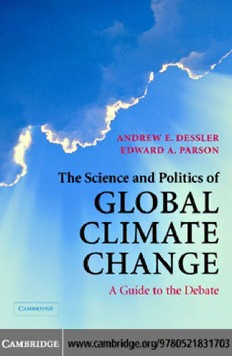
The science and politics of global climate change: a guide to the debate PDF
Preview The science and politics of global climate change: a guide to the debate
This page intentionally left blank The Science and Politics of Global Climate Change AGuidetotheDebate Whyisthedebateoverclimatechangesoconfusing?Somesaythatthereisclear evidenceofanimpendingcrisis,othersthattheevidenceforclimatechangeis weak.Somesaythateffortstocurbgreenhousegaseswillbankruptus,others thatwecansolvetheproblematmanageablecost.Inthesearguments,bothsides cannotberight.Reportsinthemediaperpetuatetheconflict:theyinvariably attempttopresentbothsidesoftheargumentinabalancedmanner.Asaresult, itishardfornon-specialiststosortoutandevaluatethecontendingclaims. Inthisaccessibleprimer,DesslerandParsoncombinetheirexpertisein atmosphericscienceandpublicpolicytohelpscientists,policymakers,andthe publicsortthroughtheconflictingclaimsintheclimate-changedebate.The authorsexplainhowscientificandpolicydebateswork,summarizepresent scientificknowledgeanduncertaintyaboutclimatechange,anddiscussthe availablepolicyoptions.Alongtheway,theyexplainWHYthedebateisso confusing. Anyonewithaninterestinhowscienceisusedinpolicydebateswillfindthis discussionilluminating.Thebookrequiresnospecializedknowledge,butis accessibletoanycollege-educatedgeneralreaderwhowantstomakemoresense oftheclimate-changedebate.Itcanalsobeusedasatextbooktoexplainthe detailsoftheclimate-changedebate,orasaresourceforsciencestudentsor workingscientists,toexplainhowscienceisusedinpolicydebates. Andrew E. Dessler isanAssociateProfessorintheDepartmentof AtmosphericSciencesatTexasA&MUniversity.HereceivedhisPh.D.in ChemistryfromHarvardin1994.HedidpostdoctoralworkatNASA’sGoddard SpaceFlightCenter(1994–1996)andthenspentnineyearsonthefacultyofthe UniversityofMaryland(1996–2005).In2000,heworkedasaSeniorPolicyAnalyst intheWhiteHouseOfficeofScienceandTechnologyPolicy,wherehe collaboratedwithTedParson.Dessler’sacademicpublicationsincludeoneother book:TheChemistryandPhysicsofStratosphericOzone(AcademicPress,2000).Hehas alsopublishedextensivelyinthescientificliteratureonstratosphericozone depletionandthephysicsofclimate. Edward A. Parson isProfessorofLawandAssociateProfessorofNatural ResourcesandEnvironmentattheUniversityofMichigan.Parsonholdsdegrees inPhysicsfromtheUniversityofTorontoandinManagementSciencefromthe UniversityofBritishColumbia,andaPh.D.inPublicPolicyfromHarvard,where hespenttenyearsasafacultymemberattheKennedySchoolofGovernment.He servedasleaderofthe‘EnvironmentalTrends’ProjectfortheGovernmentof Canadaandaseditoroftheresultingbook,GoverningtheEnvironment:Persistent Challenges,UncertainInnovations.Hismostrecentbook,ProtectingtheOzoneLayer: ScienceandStrategy(OxfordUniversityPress,2003),receivedthe2004Haroldand MargaretSproutAwardoftheInternationalStudiesAssociation.Parsonhas servedontheCommitteeonHumanDimensionsofGlobalChangeofthe NationalAcademyofSciences,andontheSynthesisTeamfortheUSNational AssessmentofImpactsofClimateChange.Hehasworkedandconsultedfor variousinternationalbodiesandforthegovernmentsofbothCanadaandthe UnitedStates,includingaperiodintheWhiteHouseOfficeofScienceand TechnologyPolicy(OSTP)wherehecollaboratedwithAndrewDessler.Hehas researched,published,andconsultedextensivelyonissuesofenvironmental policy,particularlyitsinternationaldimensions;thepoliticaleconomyof regulation;theroleofscienceandtechnologyinpublicissues;andtheanalysis ofnegotiations,collectivedecisions,andconflicts. The Science and Politics of Global Climate Change A Guide to the Debate Andrew E. Dessler DepartmentofAtmosphericSciences, TexasA&MUniversity Edward A. Parson LawSchoolandSchoolofNatural ResourcesandEnvironment,University ofMichigan Cambridge, New York, Melbourne, Madrid, Cape Town, Singapore, São Paulo Cambridge University Press TheEdinburghBuilding,Cambridge,UK Published in the United States of America by Cambridge University Press, New York www.cambridge.org Information on this title: www.cambridg e.org /9780521831703 ©AndrewE.DesslerandEdwardA.Parson2006 Thispublicationisincopyright.Subjecttostatutoryexceptionandtotheprovisionof relevantcollectivelicensingagreements,noreproductionofanypartmaytakeplace withoutthewrittenpermissionofCambridgeUniversityPress. Firstpublishedinprintformat 2005 - ---- eBook (Adobe Reader) - --- eBook (Adobe Reader) - ---- hardback - --- hardback - ---- paperback - --- paperback CambridgeUniversityPresshasnoresponsibilityforthepersistenceoraccuracyofs forexternalorthird-partyinternetwebsitesreferredtointhispublication,anddoesnot guaranteethatanycontentonsuchwebsitesis,orwillremain,accurateorappropriate. Contents Preface pagevii 1 Globalclimatechange:anewtypeofenvironmentalproblem 1 1.1 Backgroundonclimateandclimatechange 6 1.2 Backgroundonclimate-changepolicy 12 1.3 Planofthebook 16 2 Science,politics,andscienceinpolitics 18 2.1 Justificationsforaction:positivestatementsandnormative statements 19 2.2 Howscienceworks 23 2.3 Politicsandpolicydebates 34 2.4 Whenscienceandpoliticsmeet 38 2.5 Limitingthedamage:theroleofscientificassessments 41 FurtherreadingforChapter2 45 3 Climatechange:presentscientificknowledge anduncertainties 47 3.1 Istheclimatechanging? 47 3.2 Arehumanactivitiesresponsibleforglobalwarming? 66 3.3 Whatfuturechangescanweexpect?Predictingclimatechangeover thetwentyfirstcentury 76 3.4 Whatwilltheimpactsofclimatechangebe? 81 3.5 Conclusions 87 FurtherreadingforChapter3 88 4 Theclimate-changepolicydebate:impactsandpotential responses 90 4.1 Impactsandadaptation 91 4.2 Emissionsandmitigationresponses 96 v vi Contents 4.3 Puttingittogether:balancingbenefitsandcostsofmitigationand adaptation 117 4.4 Athirdclassofresponse:geoengineering 123 4.5 Conclusion:policychoicesunderuncertainty 124 FurtherreadingforChapter4 125 5 Thepresentimpasseandstepsforward 128 5.1 Climate-changepolitics:presentpositions 128 5.2 Climate-changepolitics:theargumentsagainstaction 131 5.3 Thepresentpolicydebate:useofscientificknowledgeand uncertainty 135 5.4 Sowhatshouldbedone?Majorchoicesandelementsofaneffective response 154 5.5 Conclusion 175 FurtherreadingforChapter5 177 Appendix 180 Glossary 183 References 186 Index 189 Preface TheKyotoProtocol,thefirstinternationaltreatytolimithumancontributionsto globalclimatechange,enteredintoforceinFebruary2005.Withthismilestone, binding obligations to reduce the greenhouse-gas emissions that are contribut- ingtoglobalclimatechangecameintoeffectformanyoftheworld’sindustrial countries. Thiseventhasalsodeepenedpre-existingdivisionsamongtheworld’snations that have been growing for nearly a decade. The most prominent division is betweenthemajorityofrichindustrializedcountries,ledbytheEuropeanUnion andJapan,whichhavejoinedtheProtocol,andtheUnitedStates(joinedonlyby Australiaamongtherichindustrializednations),whichhasrejectedtheProtocol aswellasotherproposalsfornear-termmeasurestolimitgreenhouse-gasemis- sions.EvenamongthenationsthathavejoinedKyoto,thereisgreatvariationinthe seriousnessandtimelinessoftheemission-limitingmeasurestheyhaveadopted, andconsequentlyintheirlikelihoodofachievingtherequiredreductions. There is also a large division between the industrialized and the developing countries.TheKyotoProtocolonlyrequiresemissioncutsbyindustrializedcoun- tries. Neither the Protocol nor the Framework Convention on Climate Change, an earlier treaty, provides any specific obligations for developing countries to limit their emissions. This has emerged as one of the sharpest points of contro- versyovertheProtocol–acontroversythatisparticularlyacutesincetheProtocol onlycontrolsindustrialized-countryemissionsforthefive-yearperiod2008–2012. Initspresentform,itincludesnospecificpoliciesorobligationsbeyond2012for eitherindustrializedordevelopingcountries.WhiletheKyotoProtocolrepresents amodestfirststeptowardaconcreteresponsetoclimatechange,therehasbeen essentiallynoprogressinnegotiatingthelarger,longer-termchangesthatwillbe required to slow, stop, or reverse any human-induced climate changes that are occurring. Asthesepoliticaldivisionshavegrownsharper,publicargumentsconcerning whatweknowaboutclimatechangehavealsogrownmoreheated.Climatechange vii viii Preface may well be the most contentious environmental issue that we have yet seen. Follow the issue in the news or in policy debates and you will see arguments overwhetherornottheclimateischanging,whetherornothumanactivitiesare causingittochange,howmuchandhowfastitisgoingtochangeinthefuture, howbigandhowserioustheimpactswillbe,andwhatcanbedone–atwhatcost– tosloworstopit.Theseargumentsareintensebecausethestakesarehigh.But what is puzzling, indeed troubling, about these arguments is that they include bitterpublicdisagreements,betweenpoliticalfiguresandcommentatorsandalso betweenscientists,overpointsthatwouldappeartobestraightforwardquestions ofscientificknowledge. Inthisbook,wetrytoclarifyboththescientificandthepolicyargumentsnow beingwagedoverclimatechange.Wefirstconsidertheatmospheric-scienceissues thatformthecoreoftheclimate-changesciencedebate.Wereviewpresentscien- tificknowledgeanduncertaintyaboutclimatechangeandthewaythisknowledge isusedinpublicandpolicydebate,andexaminetheinteractionsbetweenpoliti- calandscientificdebate–ineffect,toaskhowcantheclimate-changedebatebe socontentiousandsoconfusing,whensomanyoftheparticipantssaythatthey arebasingtheirargumentsonscientificknowledge. Wethenbroadenourfocus,toconsiderthepotentialimpactsofclimatechange, andtheavailableresponses–bothintermsoftechnologicaloptionsthatmight be developed or deployed, and in terms of policies that might be adopted. For these areas as for climate science, we review present knowledge and discuss its implications for action and how it is being used in public and policy debate. Finally, we pull these strands of scientific, technical, economic, and political argument together to present an outline of a path forward out of the present deadlock. Thebookisaimedataneducatedbutnon-specialistaudience.Acourseortwo inphysics,chemistry,orEarthsciencemightmakeyoualittlemorecomfortable withtheexposition,butisnotnecessary.Weassumenospecificpriorknowledge excepttheabilitytoreadagraph.Thebookissuitabletosupportadetailedcase- studyofclimatechangeincollegecoursesonenvironmentalpolicyorscienceand public policy. It should also be useful for scientists seeking to understand how scienceisused–andmisused–inpolicydebates. Manypeoplehavehelpedthisprojectcometofruition.Helpfulcommentson themanuscripthavebeenprovidedbyDavidBallon,StevePorter,MarkShahinian, andScottSiff,aswellasseminarparticipantsattheUniversityofBritishColumbia, theUniversityofMichiganSchoolofPublicHealth,andtheUniversityofMichigan LawSchool.A.E.D.receivedsupportforthisprojectfromaNASANewInvestiga- torProgramgranttotheUniversityofMaryland,aswellasfromtheUniversity
